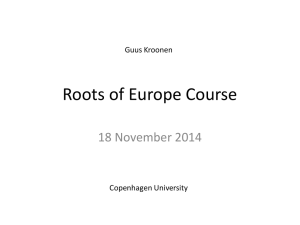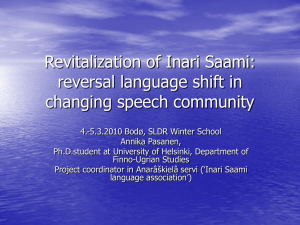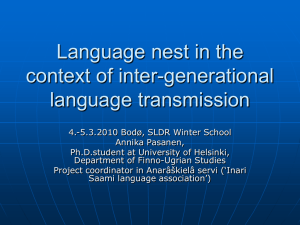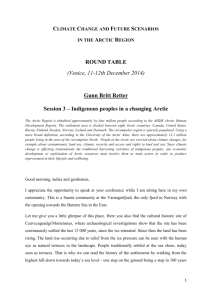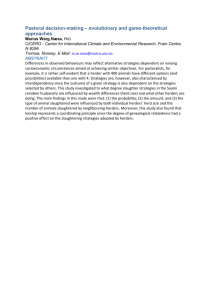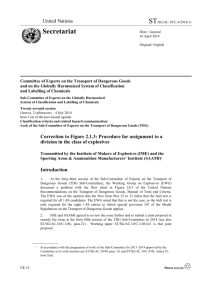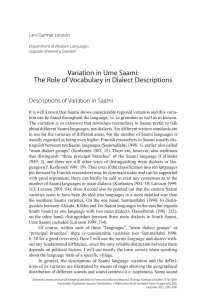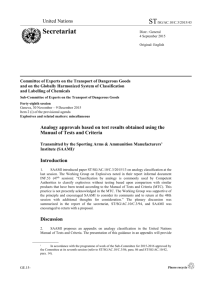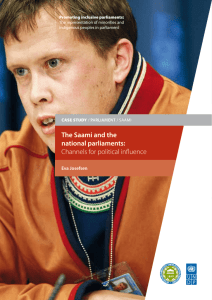introduction - Convention on Biological Diversity
advertisement
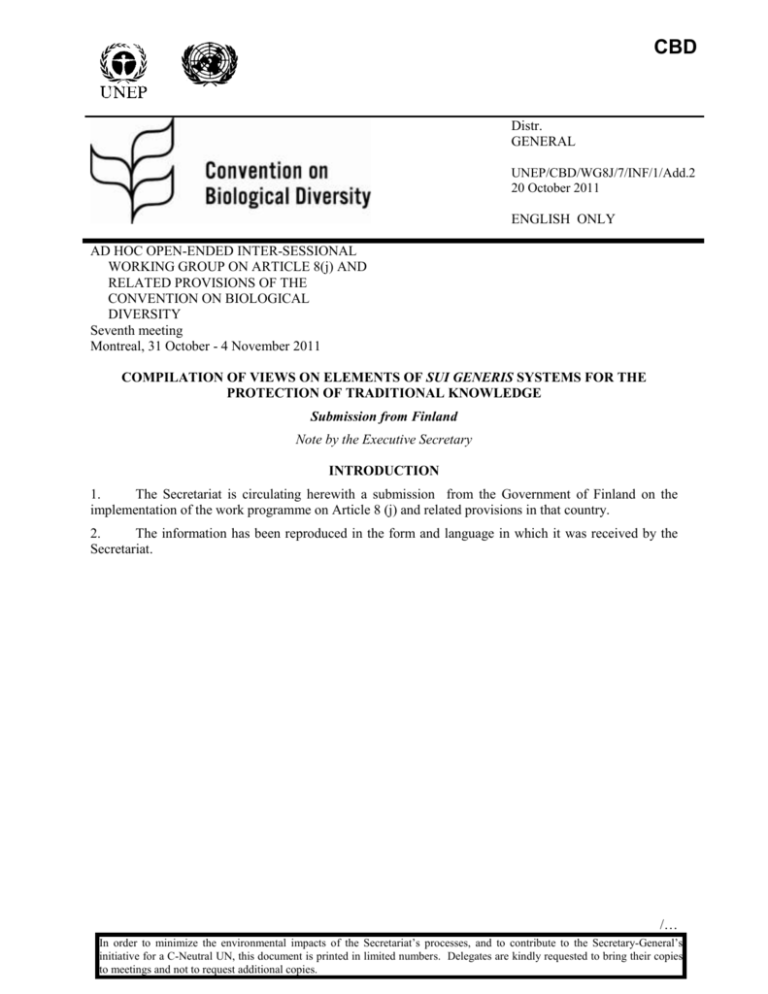
CBD Distr. GENERAL UNEP/CBD/WG8J/7/INF/1/Add.2 20 October 2011 ENGLISH ONLY AD HOC OPEN-ENDED INTER-SESSIONAL WORKING GROUP ON ARTICLE 8(j) AND RELATED PROVISIONS OF THE CONVENTION ON BIOLOGICAL DIVERSITY Seventh meeting Montreal, 31 October - 4 November 2011 COMPILATION OF VIEWS ON ELEMENTS OF SUI GENERIS SYSTEMS FOR THE PROTECTION OF TRADITIONAL KNOWLEDGE Submission from Finland Note by the Executive Secretary INTRODUCTION 1. The Secretariat is circulating herewith a submission from the Government of Finland on the implementation of the work programme on Article 8 (j) and related provisions in that country. 2. The information has been reproduced in the form and language in which it was received by the Secretariat. /… In order to minimize the environmental impacts of the Secretariat’s processes, and to contribute to the Secretary-General’s initiative for a C-Neutral UN, this document is printed in limited numbers. Delegates are kindly requested to bring their copies to meetings and not to request additional copies. UNEP/CBD/WG8J/7/INF/1/Add.2 Page 2 The Finnish Contribution and update to the CBD regarding the Programme of Work on Article 8 (j) and related provisions, in Finland. 1. Introduction The Finnish Working Group on Article 8(j) On 18 June 2009, the Ministry of the Environment set up a national group of experts in accordance with Article 8(j) regarding traditional knowledge of indigenous and local communities of the Convention on Biological Diversity. It was tasked with co-ordination of Finland’s national measures concerning traditional knowledge of indigenous and local communities as referred to in the strategy and action plan 2006–2016 for the conservation and sustainable use of biological diversity, and enhancement of general knowledge about the contents and objectives of the work programme relating to Article 8(j) of the Convention as regards the Saami people of Finland in particular. The working group aimed to promote the implementation of the work programme in Finland by co-operation between various ministries and stakeholders, and for its part to provide recommendations for the implementation and realisation of the Convention in Finland. The mandate of the working group covered the period 18 June 2009 to 30 April 2011. During its work, the working group aimed to establish a common view of how to promote the implementation of the biodiversity strategy and action plan within the administrative sector and reconcile these with other programmes adopted by the Government having points of convergence with conservation and sustainable use of biological diversity. The working group was to prepare measures based on the work programme relating to Article 8(j) of the Convention on Biological Diversity regarding the protection and maintenance of the traditional knowledge of indigenous and local communities. The working group was tasked with actively monitoring international activities and preparing Finnish participation in international conferences. The working group operated under the auspices of the working group promoting the implementation and monitoring of the national strategy and action plan 2006–2016 for the conservation and sustainable use of biological diversity (the biodiversity working group). Klemetti Näkkäläjärvi, Chairman of the Saami Parliament, acted as chairman of the working group. The stakeholders with representation in the working group included the Ministry of the Environment, the Ministry for Foreign Affairs, the Ministry of Justice, the Ministry of Education and Culture, the Ministry of Agriculture and Forestry, the Centre for Economic Development, Transport and the Environment of Lapland, Metsähallitus, the Arctic Centre at the University of Lapland, the Finnish Association for Nature Conservation, the Saami Parliament, Siida, the National Museum of the Finnish Saami and the Finnish Environment Institute. In the working group, expertise on biodiversity-related traditional knowledge of Saami was also represented. The working group held a total of 19 meetings. On 28 May 2010, the working group organised a seminar for the key authorities responsible for planning and steering of land use in the Saami areas which addressed the application of the Akwé: Kon Guidelines in Finland and observance of biodiversity-related traditional knowledge of the Saami in land use planning, environmental impact assessment and land use management. During its work, the working group heard experts and holders of biodiversity-related traditional knowledge of the Saami and those fostering it in practice. In its final report, the working group observed the COP 10 conference decisions concerning Article 8(j). The working group submitted its final report to the Ministry of the Environment in a seminar held on 7 June 2011. During its work, the working group commissioned a study into the relationship of the Akwé:Kon Guidelines to Finnish legislation, as well as a survey of the customary laws of the Saami. The working group translated the Akwé:Kon Guidelines into Finnish, and the Ministry of the Environment published them. The working group drafted /… UNEP/CBD/WG8J/7/INF/1/Add.2 Page 3 proposals for application of the Akwé: Kon Guidelines into the EIA process and implementation of the Land Use and Building Act. The final report of the working group is available at the address www.ymparisto.fi/lumonet/8j (only in Finnish for the time being). Information about Article 8(j) will be collected on the website, and the working group has proposed that the website be transformed into a CHM (Clearing-House Mechanism) service site for Article 8(j). 2. General overview on the application of Article 8(j) in Finland The Saami are the only indigenous people within the European Union. In accordance with the Finnish Constitution, as an indigenous people, the Saami have the right to maintain and develop their own language and culture. The Saami have a cultural autonomy in the Saami homeland. The Saami homeland includes the northernmost part of Finland (the areas of the municipalities of Enontekiö, Inari and Utsjoki, as well as the area of Lappi reindeer herding district in the municipality of Sodankylä). The cultural autonomy is implemented by the Saami Parliament established pursuant to the Act on the Saami Parliament (974/1995). The task of the Saami Parliament is to look after the Saami language and culture, as well as to take care of matters relating to their status as an indigenous people. In matters pertaining to its tasks, the Saami Parliament represents the Saami in national and international connections. The law also includes provisions for the obligation of the authorities to negotiate with the Saami Parliament in all far-reaching and important measures which may directly and in a specific way affect the status of the Saami as an indigenous people. The Skolt Saami have their own administrative structure, the Skolt village assembly in the Skolt area located in the municipality of Inari. In accordance with the Skolt Act, in any major projects targeting the Skolt area, the Skolt village meeting must be heard. There are also Saami people living in Russia, Sweden and Norway. Some 9,300 Saami live in Finland and about half of them speak Saami as their native language. More than 60% of the Saami live outside the Saami homeland, which brings challenges for preservation of both the Saami language and biodiversity-related traditional knowledge. The traditional livelihoods of the Saami include reindeer husbandry, fishing, hunting, gathering and handicrafts. In Finland, the obligations of the Convention on Biological Diversity on indigenous and local communities cover the Saami. The traditional and present Saami settlements are gathered around fishy waters and the pinewood zone in the Saami homeland. The Saami of northern Scandinavia are probably descended from the first inhabitants of the coast of the Arctic Ocean and people who spoke the Saami parent language. Through social contact, the coastal population of the Arctic Ocean adopted the parent Saami language and cultural features alongside or instead of their own ancient language unknown to us. The present Saami are part of the continuum of descendants of the Stone Age population that settled in the Saami region right after the ice age. There are three Saami languages spoken in Finland: North Saami, Skolt Saami and Inari Saami. All Saami languages are endangered, and the smallest, Skolt Saami and Inari Saami, particularly so. The language groups also differ from each other both culturally and in terms of livelihood. The biological diversity is abundant in the Saami homeland area, but the Arctic nature is also vulnerable. In the north, extensive ranges of fells dominate the landscape, whereas in the south large waterways and forests are more characteristic of the area. The dominant habitat types in the area are alpine heaths and meadows and birch stands, as well as swamplands. In the southern region, heath forests and old-growth forests are also common. The Arctic nature is fragile and climate change threatens to change the balance of nature in the region. New alien species and the tree line moving further and further north are changing the flora and fauna in /… UNEP/CBD/WG8J/7/INF/1/Add.2 Page 4 the region, thus also affecting the traditional use of nature in the area. Renewal of nature is slow. Solutions planned for the coming years regarding land use planning, tourism and traffic may reduce biological diversity locally and so weaken the preconditions required for practicing traditional use of nature. Tourists also find the beautiful landscapes, national parks and the rich nature of the Saami homeland interesting. Fifteen percent of the fell area habitat types have been classified as endangered. The Convention on Biological Diversity recognises that the cultures of indigenous and local communities are closely dependent on sustainable use of natural resources and underscores the importance of biodiversity-related traditional knowledge to the future of these cultures. The interaction between natural processes, people and culture has shaped the current landscape of the Saami homeland. The Saami culture is a nature-bound culture in which humans are part of the nature and do not have dominion over it. Conservation of biological diversity is vital for the future of that culture. The Saami have used and are still using large areas of land for the pursuit of their traditional livelihoods, including reindeer herding, fishing, hunting and gathering. In the Saami landscape the ancient and present uses of the area are visible as existing structures and routes. The ancient dwelling places and routes visible in the landscape tell about inhabitation patterns and movement. Very often, the old routes are still in use. The historical forest reindeer pits and systems of forest reindeer pits found in the landscape are manifestations of the hunting culture. The traditional landing places for boats are still used by fishermen. The impact of reindeer herding in the local landscape is visible, not only in the structures related to reindeer husbandry (such as fences and huts), but also in the effects the herding has on the flora. The ancient use of nature lives on in the place names in the Saami language. The values, customary law, traditions and traditional uses of land steer the way Saami communities use nature. In its final report, the working group made 28 proposals for measures and gave 11 recommendations. Among the measures, the working group proposed that the biodiversity-related traditional knowledge be observed in the development projects of legislation and administration and in education. The working group suggested that resources be directed for collection, research and revival of the biodiversity-related traditional knowledge of the Saami. The working group also proposed that new measures be included in the biodiversity strategy and action plan, currently being reformed, in order to protect the traditional knowledge. It has been recorded in the Government Programme steering the operations of the Finnish Government for the next four years that the cultural way and tradition of how the Saami use nature will be ensured in the implementation of the biodiversity strategy. The working group suggests that the Biodiversity Convention’s code of ethical conduct1 be translated into Finnish and Saami, and training and guidelines be provided for implementation of this code of conduct. Provision of training to the authorities acting in the Saami homeland area and involved in biodiversityrelated issues on the contents of Article 8(j) and biodiversity-related traditional knowledge of the Saami must also be continued. The working group also proposes that, by making relevant studies, Finland should make preparations for the introduction of the indicators adopted by the meeting of the Conference of the Parties to the Convention on Biological Diversity concerning linguistic diversity, the land use situation of the Saami homeland, and the status and development of traditional livelihoods as a means to describe the situation and development of traditional knowledge, innovations and practices. The working group suggests that Finland commit itself to the development of the operational capabilities of the Saami, and the status of women in particular, within the context of the Biodiversity Convention, and, by provision of sufficient resources, ensure the chances of the Saami to take part in these activities. The working group has drawn up general definitions of biodiversity-related traditional knowledge, traditional use of nature, customary law, and cultural expressions of the Saami people in accordance with the decisions of the meeting of the Conference of the Parties to the Convention on Biological Diversity. 1 The Tkarihwaié:ri Code of Ethical Conduct to Ensure Respect for the Cultural and Intellectual Heritage of Indigenous and Local Communities /… UNEP/CBD/WG8J/7/INF/1/Add.2 Page 5 The traditional knowledge of the Saami culture cannot be understood separate from the Saami forms of livelihood, the social system of the Saami or the Saami language. In order to comprehend the biodiversity-related traditional knowledge of the Saami, one must understand the role of Saami forms of livelihood in the Saami culture and the use of traditional knowledge in the continuum of generations. The biodiversity-related traditional knowledge of the Saami manifests itself in the Saami use of nature and the pursuit of traditional Saami forms of livelihood, including reindeer husbandry, fishing, hunting, gathering and handicrafts and in their relationship with nature. This knowledge is passed on into the Saami language in the terminology related to nature, land, weather, reindeer herding, handicrafts, hunting and fishing as well as the place names in the Saami language. Traditional knowledge is passed on through conscious teaching, models inherited from the older generations, yoik-songs and oral storytelling tradition, as well as in the practices of reindeer husbandry, fishing, hunting, gathering and handicrafts. The biodiversity-related customary law of the Saami steers the traditional use of land and intercommunity relations relating to land use; creates principles for the allocation of the areas of use; and steers the use of natural resources in a sustainable manner in keeping with the concept of justice held by the Saami. In the Saami culture, traditional cultural expression means yoik music, Saami handicrafts, Saami art, the storytelling tradition and myths, literature, place names in the Saami language and Saami building traditions. In addition, making offerings to the Seidi, which is part of the ancient Saami religion, is a form of cultural expression. Newer forms of cultural expression include modern Saami music, theatre and the cinema. The working group has stated that the preservation of the biodiversity-related traditional knowledge of the Saami requires collection, recording and return of the traditional knowledge and customs to the Saami community; funding and land use; and development of the legislation steering Saami livelihoods and education to observe the needs of the biodiversity-related traditional knowledge of the Saami. The traditional Saami knowledge and ways of using nature have been collected in various archives in written, visual and sound form in connection with ethnological research and surveys. However, traditional knowledge is not collected in a systematic manner, and the work is hampered by lack of funding, coordination, allocation of responsibilities and relevant training. The collection of traditional knowledge alone is not sufficient to preserve the traditional knowledge, customs and innovations in the manner required by the Convention on Biological Diversity, rather knowledge must also be returned to the Saami community. There are ethical and right of ownership issues related to the collection, storage and use of traditional knowledge. The biodiversity-related traditional knowledge of the Saami is part of the Saami cultural heritage, property, traditional forms of livelihood and language. The storage of traditional knowledge must not lead to the exploitation of this knowledge against the will of the Saami community, and the preservation of this knowledge must be possible within the Saami community. However, databases of traditional knowledge can provide assistance for the preservation, revival and return of traditional knowledge. The working group proposed that a working group between various ministries, the Saami Parliament and stakeholders be set up for the purpose of the implementation, monitoring and promotion of Article 8(j) and the preparation of Finland’s opinions for international conferences concerning Article 8(j). Approximately 80% of the Saami homeland is protected in one way or another and some 90% of the area is managed by Metsähallitus. Metsähallitus is a state-owned public corporation responsible for sustainable use of natural resources under government control and nature conservation. The land use of protected areas is managed by means of statutory management and utilisation plans and Metsähallitus’ own internal natural resources plans. During the mandate of the working group, Metsähallitus decided to test the application of Akwé: Kon Guidelines on the preparation of the management plan of the Hammastunturi wilderness area. The Akwé: Kon process is prepared by a joint working group set up by Metsähallitus and /… UNEP/CBD/WG8J/7/INF/1/Add.2 Page 6 the Saami Parliament with members appointed by the Saami Parliament. The members of the working group are holders of traditional knowledge and the representation covers different generations and both sexes. The management plan will probably be completed by the end of the year and, in this connection, a permanent model will be created for the application of the Akwé: Kon Guidelines to Metsähallitus operations. The purpose of the recommendations and proposals for measures suggested by the working group in its final report is to prevent the risk of diversity-related knowledge, customary law, and traditional use of nature becoming endangered, and to preserve the biodiversity of the Saami homeland in a culturally sustainable manner also for the generations to come. ----
